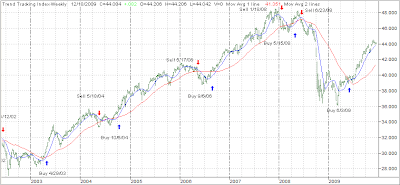 MSN Money reported a couple of days ago that “Stocks ending their worst decade ever:”
MSN Money reported a couple of days ago that “Stocks ending their worst decade ever:”
Stocks have lost value each year since the end of 1999. Even the lowly savings account performed better.
So long, 2000s. And no need to pass the tissues. We won’t get too weepy about this goodbye.
The past 10 years have been the worst decade ever for stocks, reports The Wall Street Journal. We suffered through two bear markets, and stocks on the New York Stock Exchange lost 0.5% a year, on average, since the end of 1999.
And if that doesn’t hurt enough, try rubbing some inflation on that wound. If you adjust for inflation, the S&P; 500 index has lost 3.3% a year since the 1999, the Journal reports.
No other decade has been this bad. Not the 1970s with its runaway inflation and bear market. Not the 1930s with its Depression years.
How could this happen? The 1990s pushed stock prices too high, and they came into the decade ridiculously overvalued, experts tell the Journal. Stocks in the S&P; 500 started off this decade at about 44 times earnings — and there’s nowhere to go but down in that scenario.
Even now, those stocks are at about 20 times earnings, which is higher than the historical average of 16.
So did anyone come out from this decade a winner? Gold owners, who saw the price of the previous metal spike an average of 15% a year. And bond owners, who earned returns in the 5% to 8% range.
And if this was the worst decade ever for stocks, you can bet that the economy was similarly miserable.
…
So what can we blame for the horrific numbers? Even the Journal (gasp!) suggests that we can point a finger at American capitalism.
Wall Street, given free rein to build itself into a powerhouse, ended up nearly destroying itself in the process. Americans spent too much and saved too little, thus removing a safety net that could have helped.
Obviously, two bear markets in one decade helped destroy whatever bullish sentiment was present during the remainder of the time. This proves my point that it is far more important to practice bear market avoidance than being worried about missing the bottom of a rebound in the market place.
We’ve seen that very same scenario play out last year and this year. The S&P; 500 lost over 38% in 2008 and, so far, has gained 23% in 2009. Markets go down much faster than they go up, which is why it’s such long and hard road to get back to the breakeven point.
As I have posted about throughout this year, the S&P; 500 still needs to gain another 18% from current levels just to get to the point of our sell signal on 6/23/08. Given how far the market has come off the March lows, along with an unstable economic recovery predominantly fed by stimulus, this last portion may take while to make up.
A lot of investors have been sold a bill of goods that always being in the market is the way to success. 2008 has proven them wrong, so did 2000 and the entire decade. I wonder how many decades it will take before this reality sinks in?






